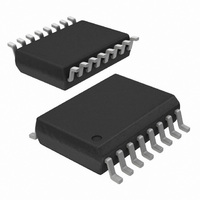AT25DF641-S3H-T Atmel, AT25DF641-S3H-T Datasheet - Page 24

AT25DF641-S3H-T
Manufacturer Part Number
AT25DF641-S3H-T
Description
IC FLASH 64MBIT 100MHZ 16SOIC
Manufacturer
Atmel
Datasheet
1.AT25DF641-MWH-T.pdf
(56 pages)
Specifications of AT25DF641-S3H-T
Format - Memory
FLASH
Memory Type
DataFLASH
Memory Size
64M (32K pages x 256 bytes)
Speed
100MHz
Interface
SPI, 3-Wire Serial
Voltage - Supply
2.7 V ~ 3.6 V
Operating Temperature
-40°C ~ 85°C
Package / Case
16-SOIC (0.300", 7.5mm Width)
Lead Free Status / RoHS Status
Lead free / RoHS Compliant
Available stocks
Company
Part Number
Manufacturer
Quantity
Price
Part Number:
AT25DF641-S3H-T
Manufacturer:
ATMEL/爱特梅尔
Quantity:
20 000
8.5.
24
The complete three address bytes must be clocked into the device before the
pin must be deasserted on an even byte boundary (multiples of eight bits); otherwise, the device will abort the
operation, the state of the Sector Protection Register will be unchanged, and the WEL bit in the Status Register
will be reset to a logical “0”.
As a safeguard against accidental or erroneous locking or unlocking of sectors, the Sector Protection Registers
can themselves be locked from updates by using the SPRL (Sector Protection Registers Locked) bit of the Status
Register (please refer to the Status Register description for more details). If the Sector Protection Registers are
locked, then any attempts to issue the Unprotect Sector command will be ignored, and the device will reset the
WEL bit in the Status Register back to a logical “0” and return to the idle state once the
deasserted.
Figure 8-4.
Global Protect/Unprotect
The Global Protect and Global Unprotect features can work in conjunction with the Protect Sector and Unprotect
Sector functions. For example, a system can globally protect the entire memory array and then use the Unprotect
Sector command to individually unprotect certain sectors and individually re-protect them later by using the
Protect Sector command. Likewise, a system can globally unprotect the entire memory array and then individually
protect certain sectors as needed.
Performing a Global Protect or Global Unprotect is accomplished by writing a certain combination of data to the
Status Register using the Write Status Register Byte 1 command (see “Write Status Register Byte 1” on page 38
for command execution details). The Write Status Register command is also used to modify the SPRL (Sector
Protection Registers Locked) bit to control hardware and software locking.
To perform a Global Protect, the appropriate
write a logical “1” to bits five, four, three, and two of the first byte of the Status Register. Conversely, to perform a
Global Unprotect, the same
five, four, three, and two of the first byte of the Status Register. Table 8-1 details the conditions necessary for a
Global Protect or Global Unprotect to be performed.
Sectors that have been erase or program suspended must remain in the unprotected state. If a Global Protect
operation is attempted while a sector is erase or program suspended, the protection operation will abort, the
protection states of all sectors in the Flash memory array will not change, and WEL bit in the Status Register will
be reset back to a logical “0”.
Atmel AT25DF641
SCK
SO
CS
SI
Unprotect Sector
MS B
HIG H-IMP E DANC E
0
0
0
1
1
2
OP C ODE
1
WP
3
1
4
and SPRL conditions must be met but the system must write a logical “0” to bits
0
5
0
6
1
7
MS B
A
8
A
9
A
10 11
WP
A
ADDR E S S B IT S A23-A0
pin and SPRL conditions must be met, and the system must
A
12
A
A
26
A
27 28
A
A
29 30
A
A
31
CS
pin is deasserted, and the
CS
pin has been
3680F–DFLASH–4/10
CS















